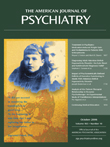One afternoon in 1971 at the Massachusetts Mental Health Center in Boston, I sat discussing ward business with Steven, who was chief resident, and I was the attending psychiatrist. The phone rang; it was a department head, and I heard shouting, vile language, and accusations directed at Steven; the caller slammed down the phone. I was filled with rage when I noticed Steven quiet and pensive. “What is it, Steven, what’s the matter?” He said, “I’m thinking, Did I do something wrong? but more important, what can I do to fix it?” At that moment I thought, “This guy could run the circus.”
And Dr. Jack Ewalt (a former APA president), the head of our hospital, thought the same. As part of the new Federal Model Cities Program, Ewalt sent Steven, a second-year psychiatry resident, out to disadvantaged Jamaica Plain, Boston, with his little black bag as a pediatrician, operating first out of church parish halls (doing summer camp physicals), then trailers, to begin a community health system. Within a few years, adroitly tapping Boston’s training programs, Steven shaped a complex community health care system, including pioneering neighborhood mental health services. Blessed with ceaseless energy, during this period he also garnered a Master’s in Public Administration degree (M.P.A.) from Harvard.
In 1976, at the age of 34, Steven moved to NIMH as Director of Community Mental Health Services in the United States—750 centers. All problems became his, be they clinical or fiscal fraud in rural Kentucky. One night in Brooklyn, a psychiatrist was beaten “within an inch of his life” by a group of Chassidic Jews after he treated a Chassidic woman for depression and suggested that part of her problem was that she was “oppressed.” Steven intervened immediately, instituting meetings with Chassidic Jews and strategic levels of the community, ultimately convening a national meeting in Washington with all the concerned groups.
As Associate Director for Behavioral Medicine at NIMH from 1980 to 1982, Steven was plunged into the world of research, the first AIDS patients, bipolar patients, psychosomatics, and even infectious disease. During the Jimmy Carter administration, Steven was part of the creation of the Mental Health Systems Act, working closely with Rosalynn Carter. From 1983 to 1986 he was Deputy Medical Director of APA.
From the beginning to the present, Steven has devotedly maintained a clinical practice, seeing patients even on Christmas and New Year’s Eve. His wife, Margaret, during blizzards would comment, “The only people on the road this evening are Steven and his patients.” Dedicated teaching has also been constant, for Georgetown, Johns Hopkins, and of course, Sheppard Pratt. Clinical psychiatry and teaching boldly illuminate Steven’s capacity to nurture, peppered with pragmatic optimism; these parental traits are embedded in his administrative success.
Wherever Steven works, innovative improvement follows. For the past 20 years at Sheppard Pratt Health System (currently as President and CEO), Steven has labored to pry open what he calls psychiatry’s “iron triangle”—access, cost, and quality of care. He shifted horizontally with 33 sites into the community and state, and vertically with the funding, building, and recent opening of a state-of-the-art psychiatric hospital (The Weinberg Building). Sheppard Pratt is now the largest psychiatric care facility in Maryland.
The presidency of APA has brought a felicitous melding of Steven’s humanistic character with urgent issues. During the past year he has championed compassionate action during disaster, safeguarding civil liberties, study of childhood violence, access to care, scrutiny of electronic record keeping, quality of training and care, credibility of public trust, and putting the “psychosocial” back into the “bio-bio-bio.” Grounded in Semrad and Sullivan, his unifying theme is, “One person’s problem is society’s problem,” and in this biopsychosocial dynamic the psychiatrist must be an advocate.
None of Steven’s drive, compassion, optimism, social nature, ethical clarity, or good humor (Steven never burns bridges) makes any sense without recognizing the loving surround of his family. Beginning with his parents—his dad Sidney, sharp of wit, imaginative in business, outgoing, and matched by his intelligently cosmopolitan mother Beverly, energetically affectionate (we are blessed with Beverly’s presence here today)—these loving people nurtured Steven’s soul for his loving marriage to Margaret, a woman whose openheartedness, intellectual acumen, and professional achievement well match Steven’s. Add to this mixture his children, Joshua, Daniel (here today with his lovely wife Ann), and Sara, and now his grandchildren, and we can feel the backdrop for Steve’s generativity. Given so much by them, he has much to give to others.
My esteemed colleagues, I present to you the Clinical Professor and Vice Chair of Psychiatry at the University of Maryland, author of more than 150 professional papers and 40 book chapters and coauthor of 10 books, the 132nd President of APA, my dear friend, Steven S. Sharfstein.

